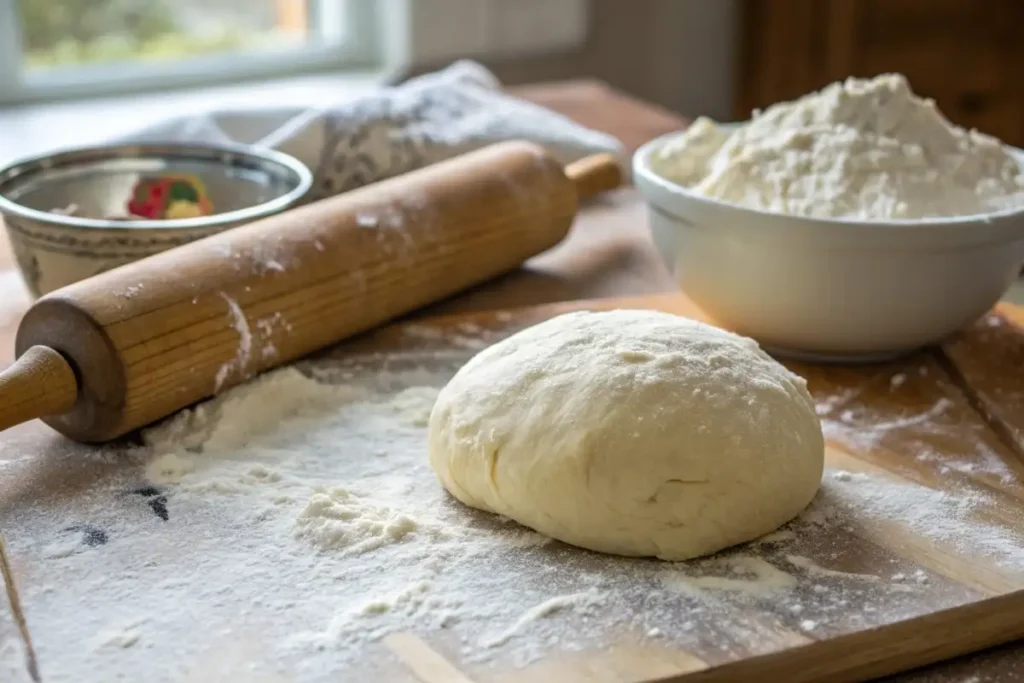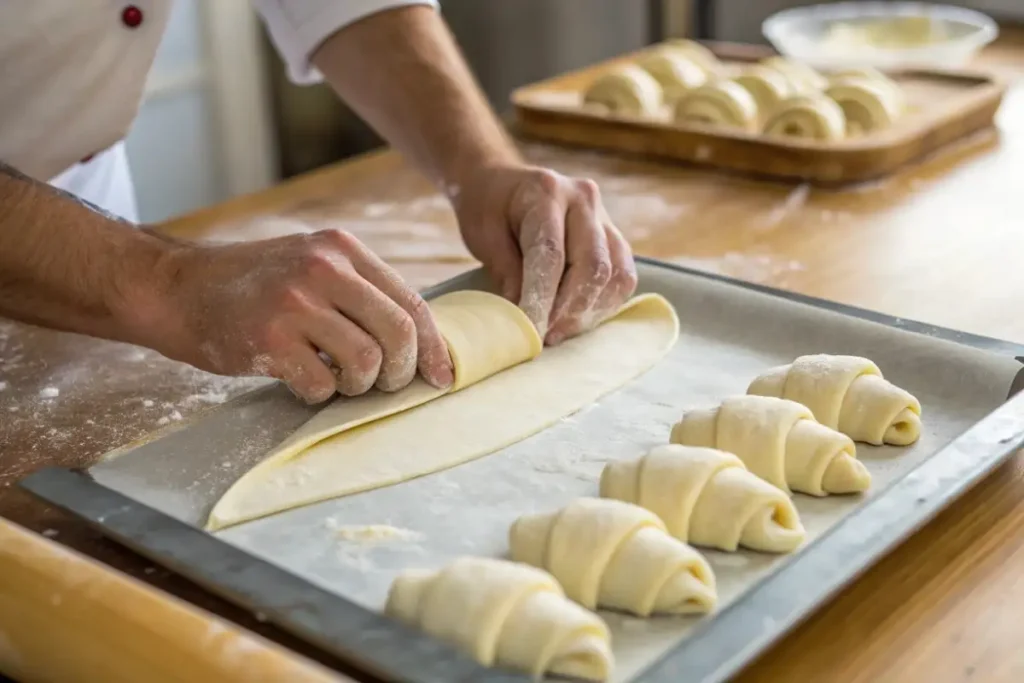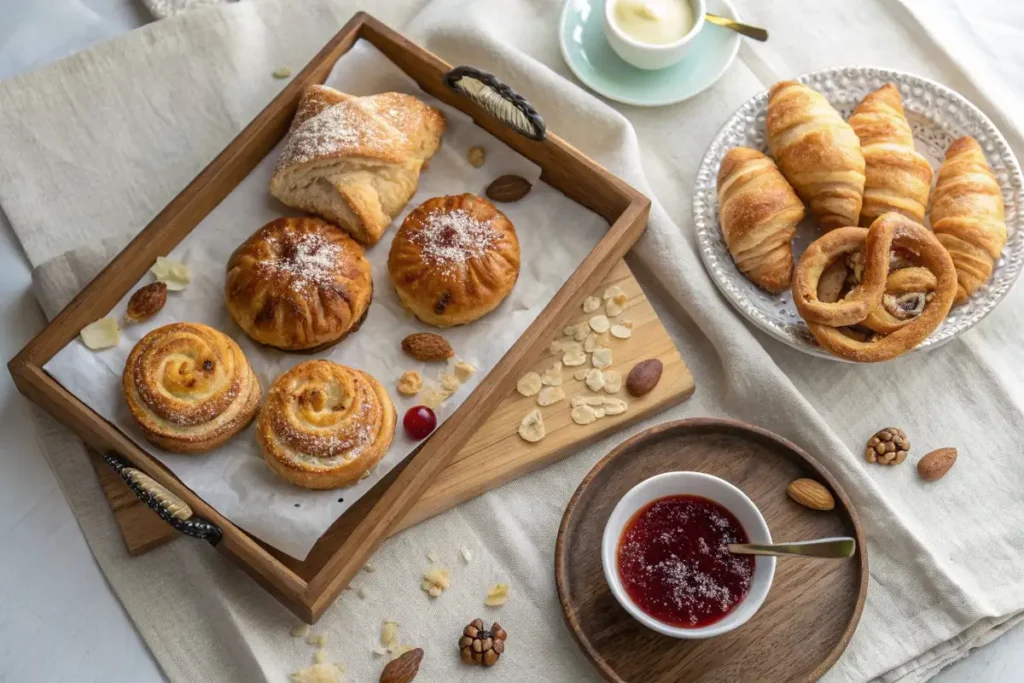Switzerland is known for its breathtaking landscapes, rich traditions, and delicious pastries. Among these, Gipfeli holds a special place as a staple of Swiss breakfasts and afternoon snacks. If you’ve ever wondered how to make an authentic Gipfeli recipe at home, you’re in the right place!
This guide covers everything you need to know about the Gipfeli recipe—its origins, how it differs from a croissant, the traditional method of making it, popular variations, serving suggestions, and answers to frequently asked questions. By the end of this article, you’ll be ready to bake Swiss croissants that taste just like those from a local bakery!
Introduction to Gipfeli
What is Gipfeli?
Gipfeli, often referred to as the Swiss version of a croissant, is a light, flaky, and buttery pastry enjoyed across Switzerland. Unlike traditional French croissants, Gipfeli has a denser texture and a less greasy feel, making it a preferred choice for many. It pairs perfectly with coffee, tea, or a hot cup of Swiss hot chocolate.
The word “Gipfeli” comes from Swiss German and translates to “little peak,” referring to its crescent shape. Though it looks similar to a croissant, Gipfeli has its own unique preparation method and variations, making it a distinct and beloved treat in Swiss bakeries.
Historical Background
The history of Gipfeli dates back centuries, with its roots embedded in European baking traditions. While croissants are thought to have originated from Austria and later gained popularity in France, the Swiss developed their own version with a slightly different technique.
In Switzerland, Gipfeli became a common breakfast item, enjoyed both at home and in cafés. Over time, variations like Mandelgipfel (almond-filled Gipfeli) and Nussgipfel (nut-filled Gipfeli) emerged, showcasing the creativity of Swiss bakers. Today, this pastry is an essential part of Swiss culture, often served fresh from bakeries or made at home for a delightful morning treat.
Differentiating Gipfeli from Croissants
Key Differences
At first glance, Gipfeli might look like a croissant, but there are some notable differences. The primary distinction lies in the dough and the baking technique. A traditional Gipfeli recipe uses less butter and fewer layers, resulting in a pastry that is less flaky but more structured. Unlike croissants, which require multiple folds of butter for an airy texture, Gipfeli dough is typically denser and slightly more bread-like.
Another major difference is the flavor profile. While croissants are rich, buttery, and often crispier, Gipfeli has a milder, slightly sweeter taste, making it ideal for both sweet and savory fillings. Moreover, Gipfeli are often smaller in size and don’t always require egg washes for a glossy finish.
Texture and Taste Comparison
Texture-wise, Gipfeli has a firmer bite, whereas croissants have a light, flaky crumble that falls apart easily. This makes Gipfeli a practical on-the-go breakfast since it holds its shape better.
In terms of taste, croissants boast a richer buttery essence, while Gipfeli has a slightly chewy consistency with a touch of sweetness. Swiss bakers sometimes add a hint of vanilla or almond essence, making their version unique.
Ultimately, if you’re looking for a pastry that’s easier to make at home while still delivering a delightful bite, a Gipfeli recipe is the perfect choice. Next, let’s dive into how you can make authentic Swiss Gipfeli from scratch!
Traditional Gipfeli Recipe
Ingredients Needed
To make an authentic Gipfeli, you’ll need the following simple ingredients:
- 500g (4 cups) all-purpose flour
- 50g (1/4 cup) sugar
- 1 packet (7g) active dry yeast
- 250ml (1 cup) warm milk
- 1/2 teaspoon salt
- 60g (1/4 cup) softened butter
- 1 egg yolk (for brushing, optional)
While croissants rely on a time-consuming butter lamination process, this Gipfeli recipe keeps it simple, making it ideal for home bakers.
Step-by-Step Preparation

1. Activate the Yeast
In a small bowl, dissolve the yeast in warm milk (not too hot, or it will kill the yeast). Add sugar and let it sit for 5–10 minutes until it foams.
2. Mix and Knead the Dough
In a large bowl, combine flour and salt. Add the yeast mixture and softened butter. Knead until you get a smooth, elastic dough—this should take around 10 minutes by hand or 5 minutes with a stand mixer.
3. Let the Dough Rise
Cover the dough with a damp cloth and let it rise for 1.5 hours in a warm place. It should double in size.
4. Shape the Gipfeli
Once risen, roll out the dough into a large rectangle (about ½ cm thick). Cut triangles of about 10 cm base and 15 cm height. Roll them from the base to the tip, forming their signature crescent shape.
5. Proof the Shaped Pastries
Place the shaped Gipfeli on a lined baking tray and let them rest for another 30 minutes. This step helps develop a light texture inside the pastry.

6. Bake to Perfection
Preheat the oven to 190°C (375°F). If desired, brush the Gipfeli with a light egg yolk wash for a golden crust. Bake for 15–18 minutes until golden brown and slightly firm.
Tips for Perfect Gipfeli
Common Mistakes to Avoid
- Using too much butter – Unlike croissants, Gipfeli require a moderate amount to maintain their signature texture.
- Skipping the second proofing – This helps the pastry develop a lighter structure.
- Overbaking – Since Gipfeli are less flaky, they can dry out quickly. Keep an eye on them!
Expert Advice for Beginners
- Use fresh yeast for a better rise.
- Don’t rush the kneading process – It’s essential for a soft yet structured bite.
- Experiment with flavors – A touch of almond extract can enhance the traditional taste.
With this simple yet authentic Gipfeli recipe, you can enjoy homemade Swiss pastries anytime. In the next section, we’ll explore exciting variations to take your Gipfeli to the next level!
Popular Variations of Gipfeli

Mandelgipfel (Almond Gipfeli)
Mandelgipfel offers a delightful twist to the traditional Gipfeli recipe. Filled with a sweet almond paste, these pastries are a favorite in Swiss bakeries. The filling typically combines ground almonds, sugar, butter, and a hint of lemon zest for freshness. Once baked, a light glaze of icing sugar or a drizzle of lemon icing adds the finishing touch. This variation provides a rich, nutty flavor that pairs perfectly with a cup of coffee or tea.
Nussgipfel (Nut-Filled Gipfeli)
For those who enjoy a hearty nut flavor, Nussgipfel is an excellent choice. This version features a filling made from ground hazelnuts or walnuts, mixed with sugar, milk, and spices like cinnamon. The nutty filling complements the buttery pastry, creating a satisfying treat. A light dusting of powdered sugar or a simple glaze often adorns the top, making it as visually appealing as it is delicious.
Laugengipfel (Pretzel-Style Gipfeli)
Laugengipfel combines the soft, chewy texture of a pretzel with the classic crescent shape of Gipfeli. Before baking, the dough is briefly dipped in a baking soda solution, giving it the characteristic pretzel-like crust and flavor. Sprinkled with coarse salt or seeds, this savory variation is perfect for those who prefer a less sweet option. It’s an excellent accompaniment to soups or can be enjoyed on its own as a savory snack.
These variations showcase the versatility of the Gipfeli recipe, allowing bakers to experiment with different fillings and toppings to suit their tastes. Whether you prefer sweet or savory, there’s a Gipfeli variation to satisfy every palate.
Serving Suggestions and Pairings
Ideal Accompaniments
Serving Gipfeli warm enhances their buttery flavor and flaky texture. For a traditional Swiss breakfast, pair your Gipfeli with a selection of jams and preserves, such as apricot or raspberry. The sweetness of the jam complements the rich pastry, creating a delightful balance of flavors.
For a savory twist, consider serving Laugengipfel with slices of Swiss cheese or cured meats. The salty notes of the pretzel-style pastry pair well with the creamy texture of cheese, making it a satisfying snack or light meal.
Beverage Pairings
A freshly brewed cup of coffee is a classic companion to Gipfeli, especially in the morning. The robust flavor of coffee balances the pastry’s richness. Alternatively, a cup of hot chocolate offers a sweet pairing, particularly enjoyed during colder months. For those who prefer tea, a mild black or herbal tea complements the delicate flavors of the pastry without overpowering them.
Exploring different accompaniments and beverages can enhance your Gipfeli experience, allowing you to enjoy this Swiss delicacy in various delightful ways.
For more delicious recipes, check out our recipe article.
Frequently Asked Questions about Gipfeli
What is the origin of Gipfeli?
Gipfeli has deep roots in Swiss baking traditions. While its shape and concept resemble a croissant, its preparation method and texture set it apart. The term “Gipfeli” comes from Swiss German, meaning “little peak,” a reference to its crescent shape. Swiss bakers have been making this pastry for generations, adapting it to local tastes by using less butter and a firmer dough. Unlike French croissants, which are ultra-flaky, Gipfeli maintains a balance between soft and slightly chewy, making it a staple in Swiss breakfasts.
How does Gipfeli differ from a croissant?
Many people assume that Gipfeli and croissants are identical, but they have distinct differences. A Gipfeli recipe typically calls for less butter and fewer layers, giving it a denser and slightly drier texture. Croissants, on the other hand, involve multiple butter layers that create a light, airy pastry. Additionally, Gipfeli often has a slightly sweet taste and a firmer bite, making it ideal for both sweet and savory fillings.
Can I make Gipfeli at home without special equipment?
Absolutely! One of the best things about the Gipfeli recipe is that it doesn’t require fancy tools. You only need a rolling pin, a mixing bowl, and a baking tray. Unlike croissants, which need a precise laminating process, Gipfeli dough is easier to work with. A little patience for proofing and shaping is all it takes to create this classic Swiss treat at home.
What are some common fillings for Gipfeli?
While plain Gipfeli is a classic choice, many Swiss bakeries offer filled versions to suit different tastes. Popular options include:
- Almond paste (Mandelgipfel) – A rich and nutty filling that enhances the pastry’s sweetness.
- Nut-filled (Nussgipfel) – Ground hazelnuts or walnuts mixed with sugar and spices for extra depth.
- Chocolate – A favorite among chocolate lovers, similar to a Swiss-style pain au chocolat.
- Savory options – Some variations include ham and cheese or a herb-infused butter spread.
The best part? You can easily customize your Gipfeli recipe by experimenting with different fillings to match your personal preference!
Conclusion
Embracing the Tradition of Gipfeli Baking
Whether you’re a seasoned baker or trying your hand at Swiss pastries for the first time, mastering the Gipfeli recipe is a rewarding experience. With its unique texture, rich history, and endless variations, Gipfeli remains a cherished part of Swiss culinary culture.
So, why not bring a taste of Switzerland to your home? With the right ingredients, a little patience, and a love for baking, you can create Gipfeli that rival those from the best Swiss bakeries. Happy baking!
For more delicious recipes, check out our latest baking guides and pastry recipes on the website.


1 thought on “Mastering the Art of Gipfeli: A Comprehensive Guide”